A Scion Society of The Baker Street Irregulars
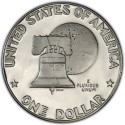
The 1976 Bicentennial Dollar and Sherlock Crater
“… If we went round the moon it would not make a penny-worth of difference to me or to my work.”
– A Study In Scarlet (STUD)
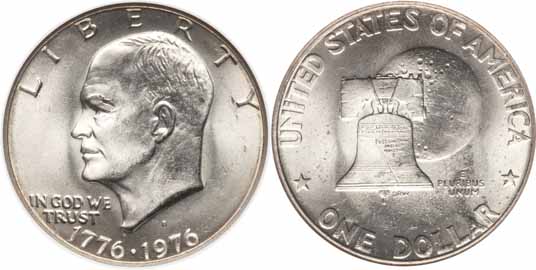
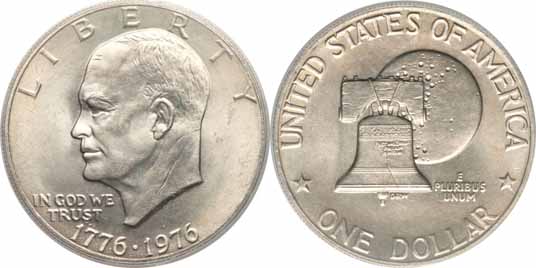
Type 1 Dollar (top) and Type 2 Dollar (bottom) – Different Reverse Fonts
GIVE A CARICATURIST a pen and the assignment to draw a numismatist, and the almost inevitable result will be the depiction of a collector holding a magnifying glass in one hand, a coin in the other. Make a similar request, but ask that the caricature be drawn as a detective, and chances are strong that the result will be similar — a man holding a magnifying glass in one hand, a clue to be examined in the other.
Clues of variety, date, mintmark or error are sought by collectors, much like telltale marks are studied by detectives with equal diligence. The caricaturist may present subtle differences in depiction, however. The collector will be of anonymous personality. The detective, on the other hand, may be dressed in Victorian garb — deerstalker atop his head, Inverness cape draped over his shoulders, all in recognition of and due homage to the world’s most famous sleuth — Sherlock Holmes.
Despite the parallel considerations of caricature, the numismatist and mystery fan of the great fictional detective seldom cross paths. One exception reigns, however minute, on the reverse of a legal-tender United States Mint issue: the 1976 Eisenhower Bicentennial dollar. Here, for the collector of unlimited imagination, can be found the precise location of the world’s sole extraterrestrial site bearing the name of literature’s well-known detective.
Few middle-school science students are unaware of the fact that the moon’s gravitational pull governs the tides of the earth. More advanced students learn that the earth exerts an even stronger influence on the movements of its solar companion. Earth’s pull keeps the same surface of the moon facing the globe. It leaves but two surfaces of the moon to explore — the far side, which cannot be seen from the earth, and the near side, seen except when the earth’s shadow is cast upon its face. The peaks, valleys, seas and craters remain as constant to our view as textbook pictures.
Lunar probes have plotted both sides of the moon. Major “lunarmarks” on both sides have been named for the famous, the not-sofamous and the downright unknown. The privilege of identifying specifics has gone to astronomers, scientists and, in this half-century, to astronauts who have explored space.
Apollo 17, the last of the lunar exploratory series, lifted off from Cape Kennedy for its journey to the moon on December 7, 1972. Three men were on board: Harrison “Jack” Schmitt, the only civilian geologist to walk on the moon; Captain Eugene Cernan, making his second flight to the area; and Commander Ronald Evans, who remained aboard the command module while his companions toured the moon’s surface.
Apollo 17 attained moon orbit early on the afternoon of December 10. With each pass over the far side, radio communications with the earth temporarily ceased. The three astronauts aboard spent as much time as possible while in orbit looking out their spacecraft window to identify the lunar surface below. At one point, Jack Schmitt reported seeing a flash of light coming from the northeast corner of the crater Grimaldi. It was later speculated that the light came from a small meteorite striking the moon’s surface. Evans, while alone in orbit, later reported a similar flash in the vicinity of the crater Orientale.
At 1100 hours on the morning of December 11, Cernan and Schmitt donned their space suits and entered the lunar landing module, Challenger. Cernan, looking down on the surface of the moon as he and his companion glided into orbit toward their preselected landing site, called out the names of the major peaks, craters and other features in the vicinity: Taurus Mountains, TaurusLittrow Valley, Sea of Serenity, and the craters Emory, Steno, Hiss, Faust, Mackin, Powell, Camelot and Sherlock. Sherlock!!
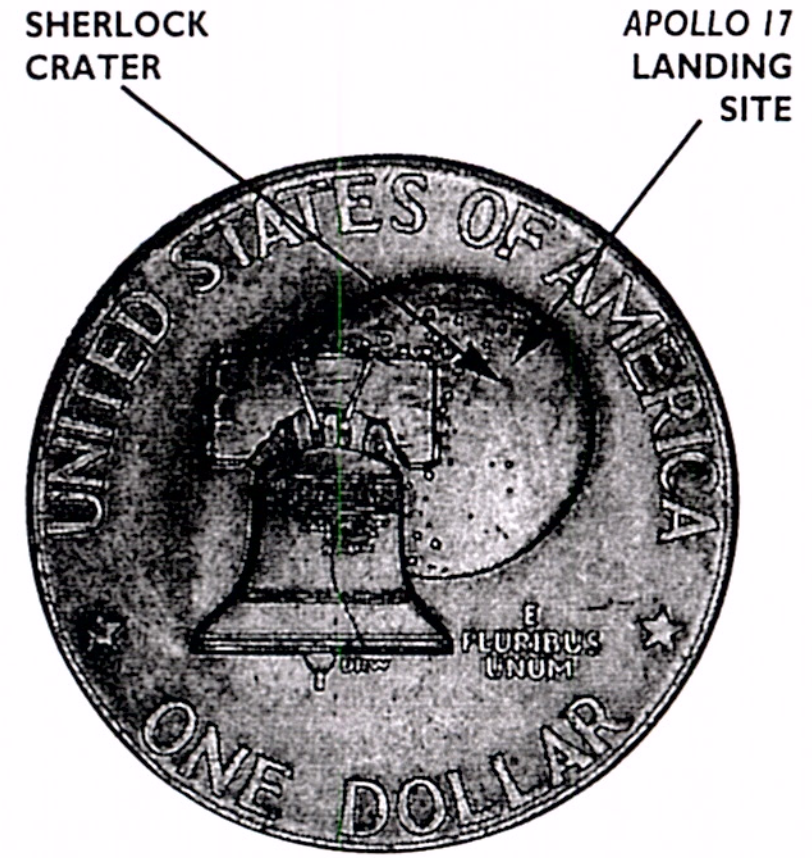
Actual Size: 38.1 mm
With unlimited imagination, numismatists and mystery fans can join to pinpoint the universe’s only extraterrestrial site bearing the given name of Sherlock Holmes — on the reverse side of an Eisenhower Bicentennial dollar. Sherlock Crater is not far from the Apollo 17 landing site.
Yes, Sherlock, the first topographical feature in the universe to bear the name of the world’s most famous detective (a rise of land near Tulsa, Oklahoma, was later called Holmes Peak. That is a story in itself and owes its appellation to Sherlock’s success in the return of the Vatican cameos).
Cernan brought the lunar landing module to a perfect touchdown at 2:55 p. m. on the afternoon of December 11, just southeast of the dry Sea of Serenity. Cernan and Schmitt remained in their spacecraft for several hours. They radioed back a description of their surroundings to assure Houston space command that they had indeed landed where they were supposed to.
After assembling the lunar rover, Cernan and his companion drove off on a moon traverse to Steno Crater. As happens occasionally on earth, Cernan experienced a fender bender.
The right fender of the lunar rover crumbled. Dust raised by the vehicle’s wire-meshed wheel spewed all over the rover and its two occupants, curtailing longer trips.
Without further mishap, and after gathering their haul of lunar samples, film and cameras, Cernan and Schmitt left the moon’s surface on the afternoon of December 14. For the next two days, after rendezvousing with the command module, they continued to orbit the moon and conduct further experiments. On December 19, the astronauts returned to earth in a perfect splashdown in the Pacific Ocean, 350 miles southeast of Samoa.
Less than a year after the astronauts’ safe return, Mary Brooks, then director of the United States Mint, announced an open competition to redesign the reverses of the quarter, half dollar and dollar. The designs were to recognize the forthcoming celebration of the Bicentennial of American Independence. The obverse designs of these coins were to remain the same, save for the inclusion of the dual date 1776-1976. Nearly 1, 000 entries were received from professional artists, sculptors, students and the general public. Review panels reduced the number to 12 semifinalists, including the work of Dennis R. Williams, then a junior majoring in sculpture at the Columbus (Ohio) College of Art and Design.
Williams’ artistic submission was for the dollar coin. He chose to depict the Liberty Bell and a full moon. He attached a note to his submission saying that should his design be selected for the half dollar, a half moon should be shown; and, likewise, should it be considered for the quarter dollar, the moon should be depicted at its quarter.
The judges selected Williams’ design for the dollar, for it represented the full scope of America’s 200 years of achievement — from Liberty in 1776 to the recently completed accomplishments in space exploration. The young student, however, was not yet an experienced sculptor. Contest rules stipulated that winning artists had to complete and submit actual plaster models of their entries. Director Brooks insisted the rules be followed to the letter. Williams’ work was somewhat rigid, his lettering too bold.
Chief Engraver of the U. S. Mint Frank Gasparro made subtle mechanical changes, but the lettering remained less than desirable. Criticism brought further change soon after the coin was released, resulting in two varieties for the reverse design of the Bicentennial dollar: Variety I, with its low, shallow relief on the main devices and bolder lettering; and Variety II, with more sharply defined features and refined lettering. The full view of the moon remained, leaving collectors with overactive imaginations the opportunity to point to the only extraterrestrial site to bear the name of the world’s most famous non-person — Sherlock Holmes.
In closing, my special thanks go to James W. McCulla, director of the National Aeronautics and Space Administration in Washington, D. C. , for his valuable assistance.
Originally published in the July 1994 issue of The Numismatist with the title of There’s More On A Bicentennial Dollar Than First Meets The Eye.
Thanks to Kendra Johnson, Librarian of the American Numismatic Association, for providing scans of this article to reprinted.
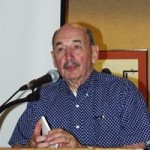 A prolific writer, Edward C. Rochette has authored several numismatic books, including The Romance of Coin Collecting, Medallic Portraits of John F. Kennedy and Making Money: Rogues and Rascals Who’ve Made Their Own. For many years, he wrote a weekly coin column nationally syndicated by the Los Angeles Times and a monthly column for COINage magazine, and penned his monthly column The Other Side of the Coin for the ANA’s The Numismatist magazine.
A prolific writer, Edward C. Rochette has authored several numismatic books, including The Romance of Coin Collecting, Medallic Portraits of John F. Kennedy and Making Money: Rogues and Rascals Who’ve Made Their Own. For many years, he wrote a weekly coin column nationally syndicated by the Los Angeles Times and a monthly column for COINage magazine, and penned his monthly column The Other Side of the Coin for the ANA’s The Numismatist magazine.

[…] Since 2019 is the 50th anniverary of the first moon landing, our card discussed Sherlock Crater and how you can see it on a 1976 Bicentennial Eisenhower dollar coin. You can learn more about the Bicentennial Dollar and Sherlock Crater by clicking HERE. […]